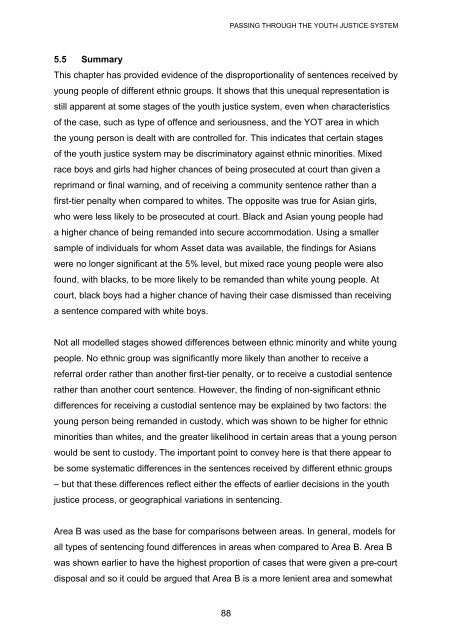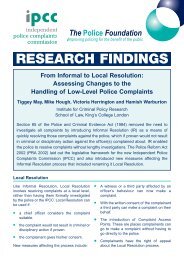Differential treatment in the youth justice system - Equality and ...
Differential treatment in the youth justice system - Equality and ...
Differential treatment in the youth justice system - Equality and ...
You also want an ePaper? Increase the reach of your titles
YUMPU automatically turns print PDFs into web optimized ePapers that Google loves.
PASSING THROUGH THE YOUTH JUSTICE SYSTEM5.5 SummaryThis chapter has provided evidence of <strong>the</strong> disproportionality of sentences received byyoung people of different ethnic groups. It shows that this unequal representation isstill apparent at some stages of <strong>the</strong> <strong>youth</strong> <strong>justice</strong> <strong>system</strong>, even when characteristicsof <strong>the</strong> case, such as type of offence <strong>and</strong> seriousness, <strong>and</strong> <strong>the</strong> YOT area <strong>in</strong> which<strong>the</strong> young person is dealt with are controlled for. This <strong>in</strong>dicates that certa<strong>in</strong> stagesof <strong>the</strong> <strong>youth</strong> <strong>justice</strong> <strong>system</strong> may be discrim<strong>in</strong>atory aga<strong>in</strong>st ethnic m<strong>in</strong>orities. Mixedrace boys <strong>and</strong> girls had higher chances of be<strong>in</strong>g prosecuted at court than given areprim<strong>and</strong> or f<strong>in</strong>al warn<strong>in</strong>g, <strong>and</strong> of receiv<strong>in</strong>g a community sentence ra<strong>the</strong>r than afirst-tier penalty when compared to whites. The opposite was true for Asian girls,who were less likely to be prosecuted at court. Black <strong>and</strong> Asian young people hada higher chance of be<strong>in</strong>g rem<strong>and</strong>ed <strong>in</strong>to secure accommodation. Us<strong>in</strong>g a smallersample of <strong>in</strong>dividuals for whom Asset data was available, <strong>the</strong> f<strong>in</strong>d<strong>in</strong>gs for Asianswere no longer significant at <strong>the</strong> 5% level, but mixed race young people were alsofound, with blacks, to be more likely to be rem<strong>and</strong>ed than white young people. Atcourt, black boys had a higher chance of hav<strong>in</strong>g <strong>the</strong>ir case dismissed than receiv<strong>in</strong>ga sentence compared with white boys.Not all modelled stages showed differences between ethnic m<strong>in</strong>ority <strong>and</strong> white youngpeople. No ethnic group was significantly more likely than ano<strong>the</strong>r to receive areferral order ra<strong>the</strong>r than ano<strong>the</strong>r first-tier penalty, or to receive a custodial sentencera<strong>the</strong>r than ano<strong>the</strong>r court sentence. However, <strong>the</strong> f<strong>in</strong>d<strong>in</strong>g of non-significant ethnicdifferences for receiv<strong>in</strong>g a custodial sentence may be expla<strong>in</strong>ed by two factors: <strong>the</strong>young person be<strong>in</strong>g rem<strong>and</strong>ed <strong>in</strong> custody, which was shown to be higher for ethnicm<strong>in</strong>orities than whites, <strong>and</strong> <strong>the</strong> greater likelihood <strong>in</strong> certa<strong>in</strong> areas that a young personwould be sent to custody. The important po<strong>in</strong>t to convey here is that <strong>the</strong>re appear tobe some <strong>system</strong>atic differences <strong>in</strong> <strong>the</strong> sentences received by different ethnic groups– but that <strong>the</strong>se differences reflect ei<strong>the</strong>r <strong>the</strong> effects of earlier decisions <strong>in</strong> <strong>the</strong> <strong>youth</strong><strong>justice</strong> process, or geographical variations <strong>in</strong> sentenc<strong>in</strong>g.Area B was used as <strong>the</strong> base for comparisons between areas. In general, models forall types of sentenc<strong>in</strong>g found differences <strong>in</strong> areas when compared to Area B. Area Bwas shown earlier to have <strong>the</strong> highest proportion of cases that were given a pre-courtdisposal <strong>and</strong> so it could be argued that Area B is a more lenient area <strong>and</strong> somewhat88






